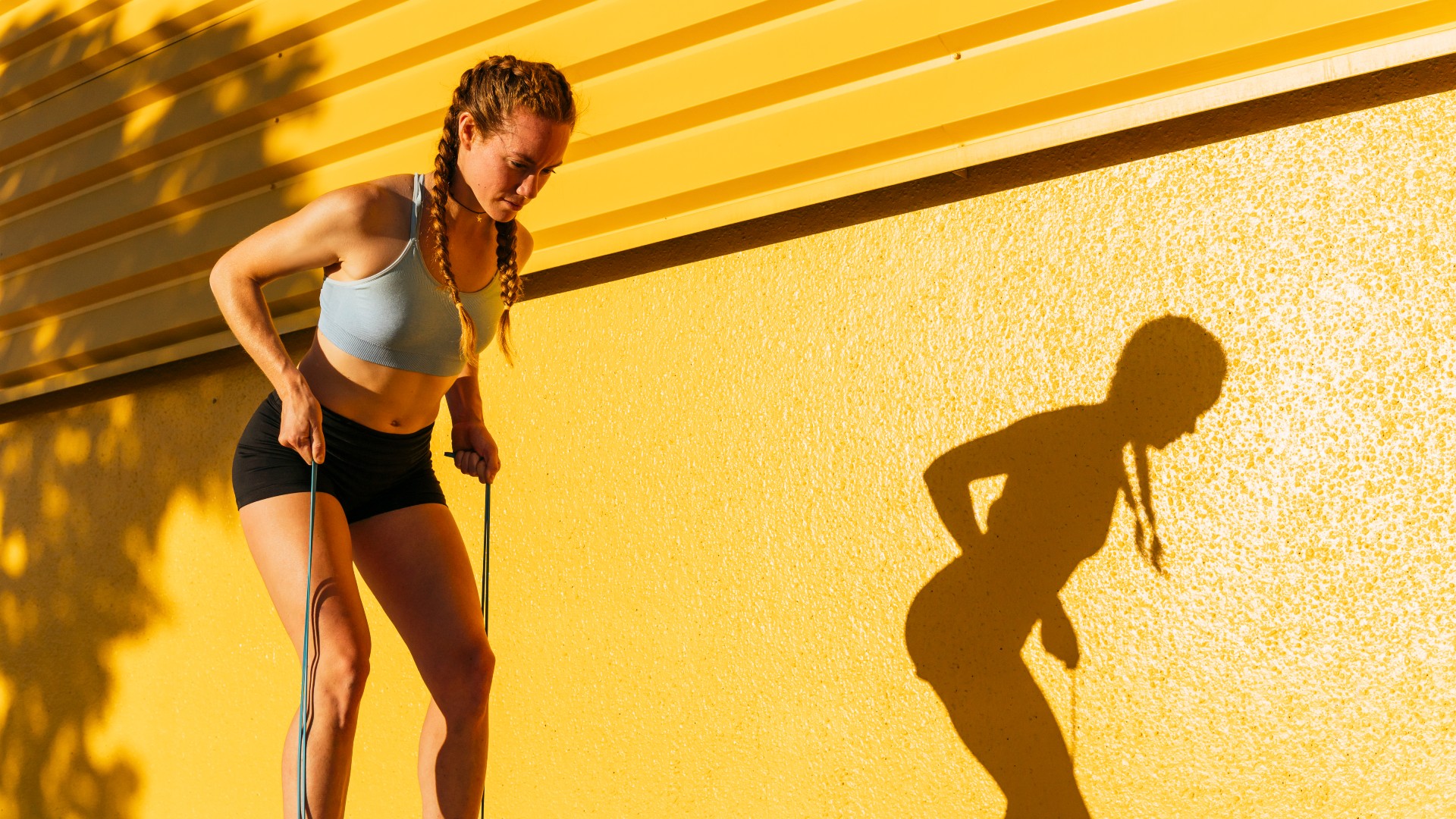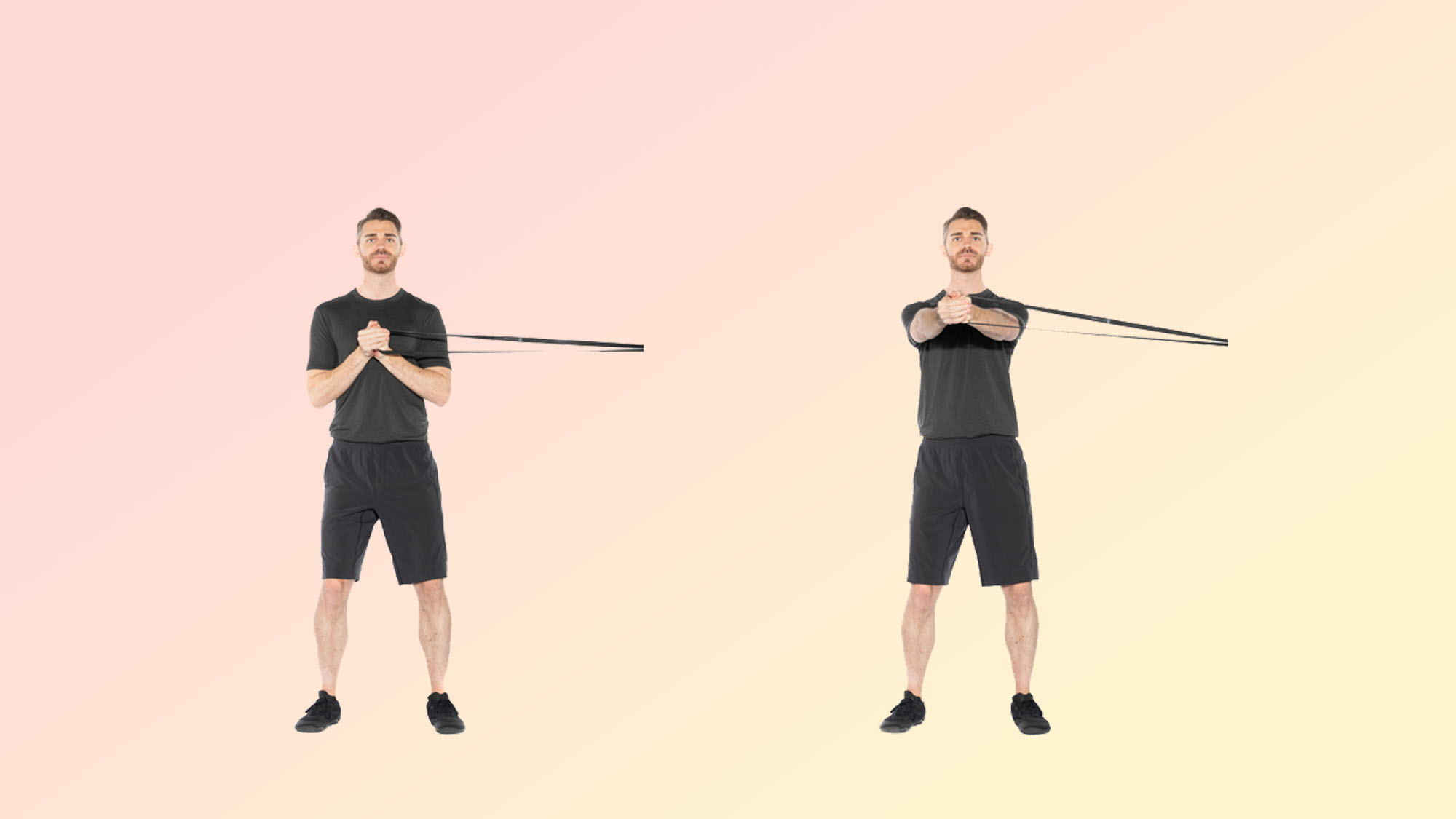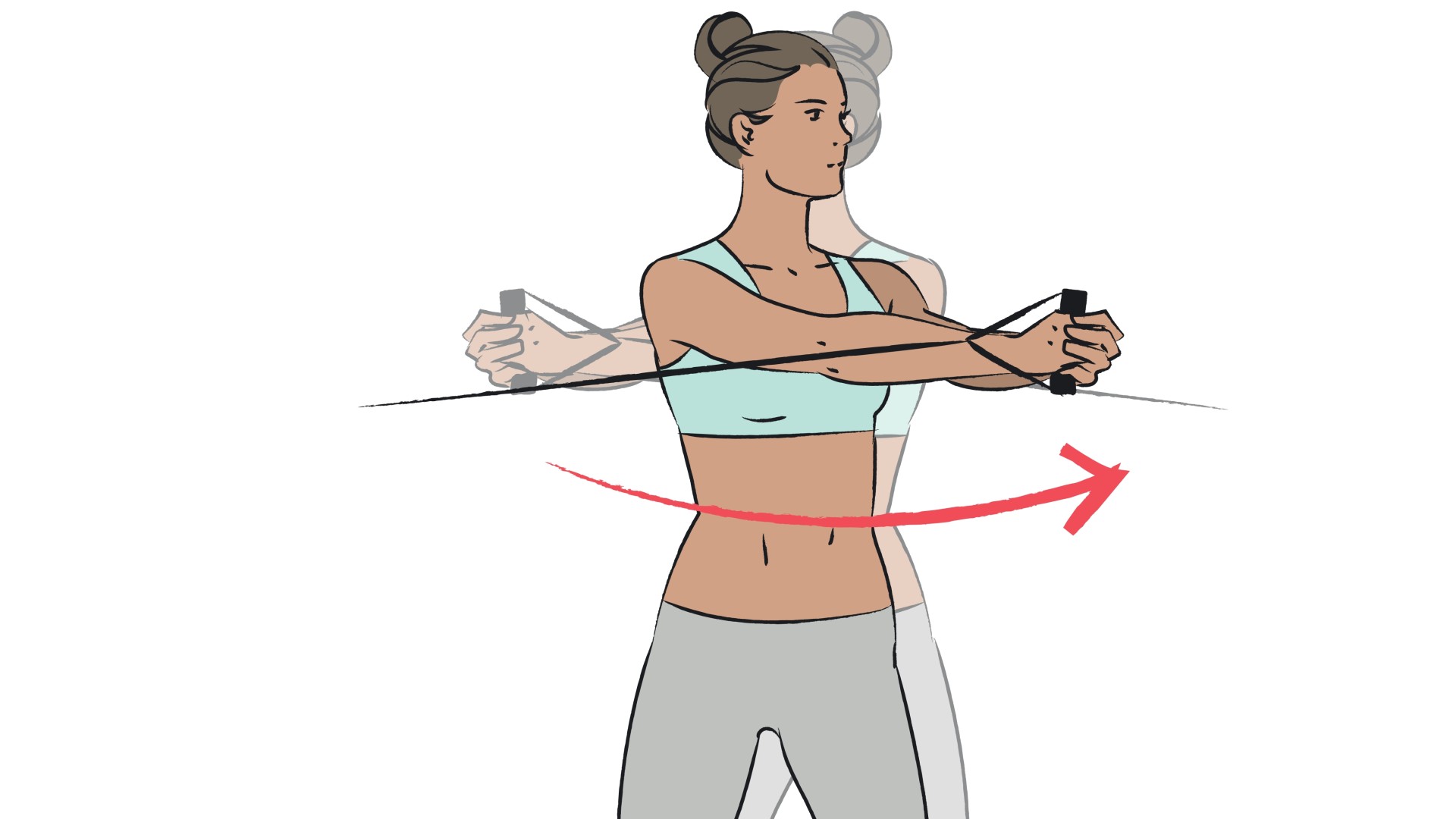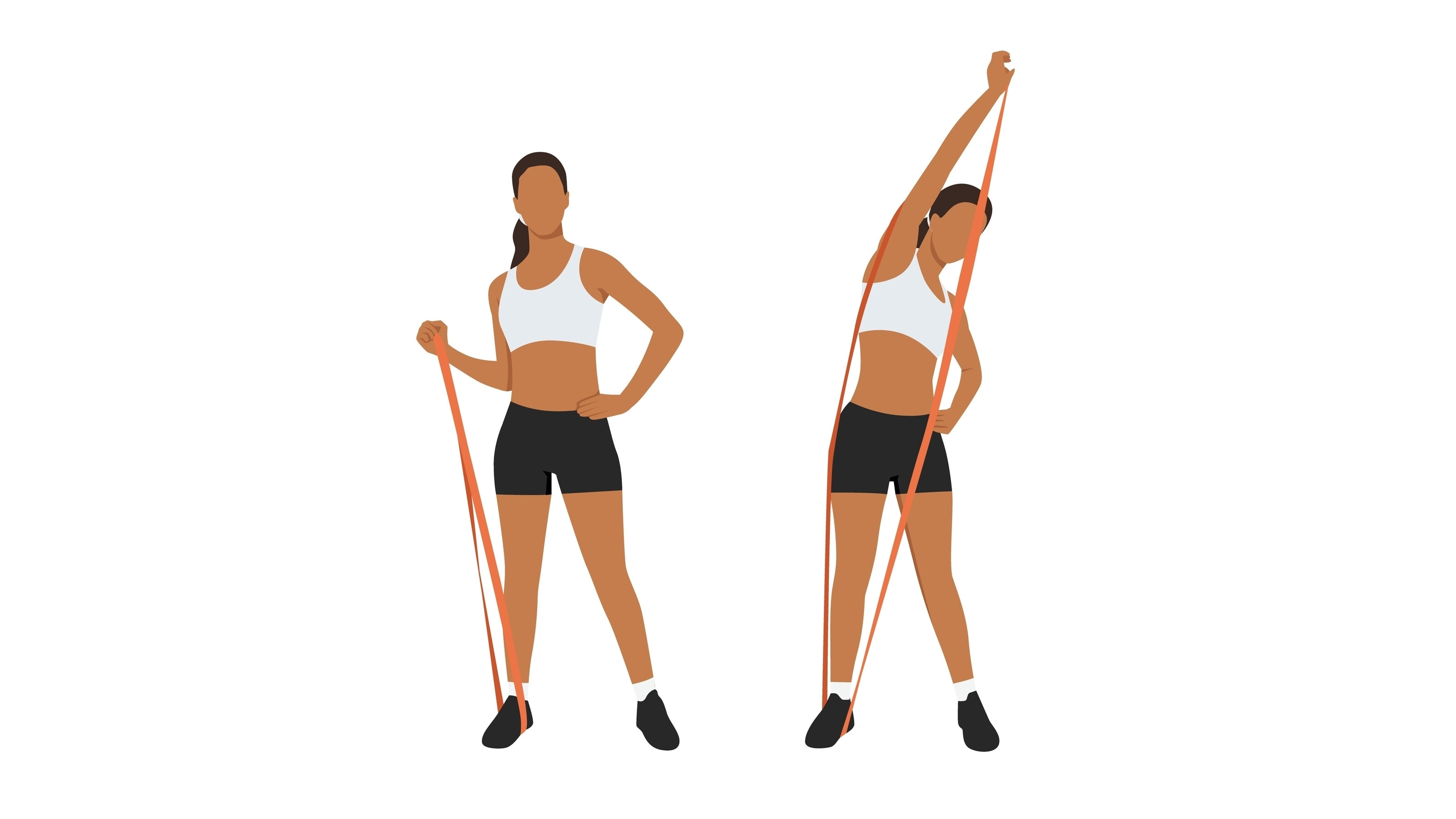
Use these standing ab exercises to build and strengthen your core using one resistance band without heavy weights. Although we love barbells, dumbbells and kettlebells, you don’t always have to default to them during gym and home workouts. Here’s how to take any of the best resistance bands and torch your core with them.
These ab exercises work incredibly well together, building a beast of a standing abs resistance band workout that can slot into any lunchtime routine. All you need is 18 minutes and three moves — and we also recommend a motivating playlist to see you through.
If that doesn’t sound like enough time to torch your muscles, did you know that research suggests shorter bursts of intense exercise throughout the day, lasting just 15-20 minutes, could be as beneficial for your health? Here’s how to make those minutes count.

If you’re returning to exercise post-injury or pregnancy, or if you have a lower back injury of any kind, we strongly advise clearing exercise regimes with a qualified medical professional and a personal trainer if you have one. Remember to work at your ability and scale exercises as necessary, stopping if you experience prolonged pain.
Forget dumbbells — what are the 3 resistance band standing ab exercises?
Before we get to the resistance band ab exercises, let’s briefly cover whether ab definition workouts exist. Whatever equipment you use, ab workouts that follow progressive overload principles can help build and strengthen your core muscles, but training your abs does not a six-pack make. Progressive overloading can help grow muscle (hypertrophy training) and manipulate overall exercise volume to keep muscles adequately challenged.
But while you can strengthen and grow muscles, you’ll need to target fat loss if you can’t see your abs yet despite working out. Some people have consistent workout regimes and follow a balanced diet yet never yield a coveted six-pack, so it’s worth looking holistically at your lifestyle and managing a range of factors — sleep, stress and diet are just a few. And if it doesn’t happen? There are many more benefits of core workouts that don’t involve a six-pack.
1. Resistance band Pallof press

Tie your resistance band around a squat rack or stable pole around shoulder height. Hold one end loop of your resistance band with both hands and take a big step away from the anchor point to create tension through the band. Hold the band close to your chest with elbows bent, feet hip-width apart, and stomach and glutes braced. The anchor point should be side-on. As you exhale, press the resistance band away from you while extending both arms, maintaining a shoulder-height position. Resist turning your body toward the anchor point, and hold for 5-10 seconds, then draw the band back in.
Remember to switch sides.
Here’s what happened when I did the Pallof press every day for a week.
2. Resistance band standing ab twists

Keep your resistance band secured (as above) and lower it slightly to chest height. Stand with your feet wider than shoulder-width apart and grip the band with both hands. Sep away from the anchor point to create tension through the band. Extend your arms away from you and brace your stomach, turn slightly towards the anchor point, then pull powerfully away to rotate your torso in the opposite direction. Keep your feet planted and position your body side-on to the anchor point while moving with control.
It will feel like a Russian twist but with a higher arm position. Remember to switch sides.
3. Resistance band side bends
Side bends are great at activating the oblique muscles that run down the sides of your waist. These muscles respond well to side flexion and rotational movements. Start with feet hip-width apart and a soft knee bend. Double-wrap the resistance band, secure one end underneath your right foot and hold the other in your right hand.
Stand tall and engage your stomach muscles, then bend your torso slowly to the right, lowering your hand along the outside of your right leg while allowing the band to go loose. Pause, then pull against the band as you stand tall again. If this doesn’t feel challenging, use a thicker resistance band or hold the band lower down to create more tension. Avoid leaning forward or backward, and remember to switch sides.

If you still struggle, loop your right foot through the band, grip the other end of your band with an underhand grip, then punch your arm above you. From here, bend over to the left without thrusting your hips forward. Return to center and complete reps before switching sides.
3-move standing ab resistance band workout to try
50 seconds on/ 10 seconds off x 6 rounds
- Resistance band Pallof press
- Resistance band standing ab twists
- Resistance band side bends
Work on your right side for the first round of exercises without switching sides, then switch to your left side for the next round, and so on. You’ll complete three rounds per side. Count your reps on the first round and try to match or beat the reps on the remaining rounds. It will keep you accountable and consistent, but don’t rush to hit the reps — always move with complete control.
Reps are guidelines only, so increase or decrease as necessary. We recommend checking out the different types of resistance bands out there to determine which will help you achieve your goals.
What we like about the resistance band standing ab exercises
There’s a lot of talk about whether resistance bands really work. The answer is — yes, they do. However, it can be harder to overload larger muscle groups like the legs and back using resistance bands, so many people prefer dumbbells, barbells, kettlebells, or gym machines. That doesn’t mean it can’t be done! You just might have a chore on your hands to ramp up the intensity enough, especially if your muscles are well-trained.
Resistance bands work incredibly well for stabilizer muscle groups like the glutes and core, plus the arms and shoulders, and help build stability and functional strength. The standing ab exercises above respond well to resistance bands and it won't take long to feel the burn in the working muscles. For example, the resistance band Pallof press is similar to the cable machine variation, except you don’t have a weight stack to play with, so instead, play around with how far away you stand from the anchor point and create tension through the band.
Focus on slowing exercises down and working your muscles through a full range of motion while keeping reps as consistent as possible across all six rounds. If that means cutting back on the reps, no problem. You’ll find your muscles working closer to fatigue by adopting proper form rather than hammering through reps without engaging the correct muscles.
During these ab exercises, the deeper core muscles like the erector spinae, transverse abdominis, glutes and hip flexors act as stabilizers, and your back, shoulders, chest and arms help facilitate movement. Squeeze your glutes and stomach as you move, and remember to relax your shoulders away from your ears.







